Social Justice and its Impact on Australian Communities
VerifiedAdded on 2021/06/18
|10
|1890
|26
Essay
AI Summary
This essay provides an in-depth analysis of social justice within the Australian context. It examines the core concepts of social justice, emphasizing its importance in fostering equitable relations and fair opportunities for all individuals. The discussion delves into the historical perspective of social justice in Australia, specifically highlighting the injustices faced by Aboriginal and Torres Strait Islander peoples and the government's responses, including the establishment of the Aboriginal and Torres Strait Islander Social Justice Commissioner. The essay further explores how social justice extends to other marginalized communities, such as immigrants, and the initiatives undertaken by both governmental and non-governmental organizations to promote their inclusion and well-being. It references key events, such as the Royal Commission into Aboriginal Deaths in Custody, and highlights the ethical and legislative rights put in place to address past and present inequalities. The conclusion underscores the significance of social justice as a fundamental human right, essential for building a harmonious and prosperous society in Australia.
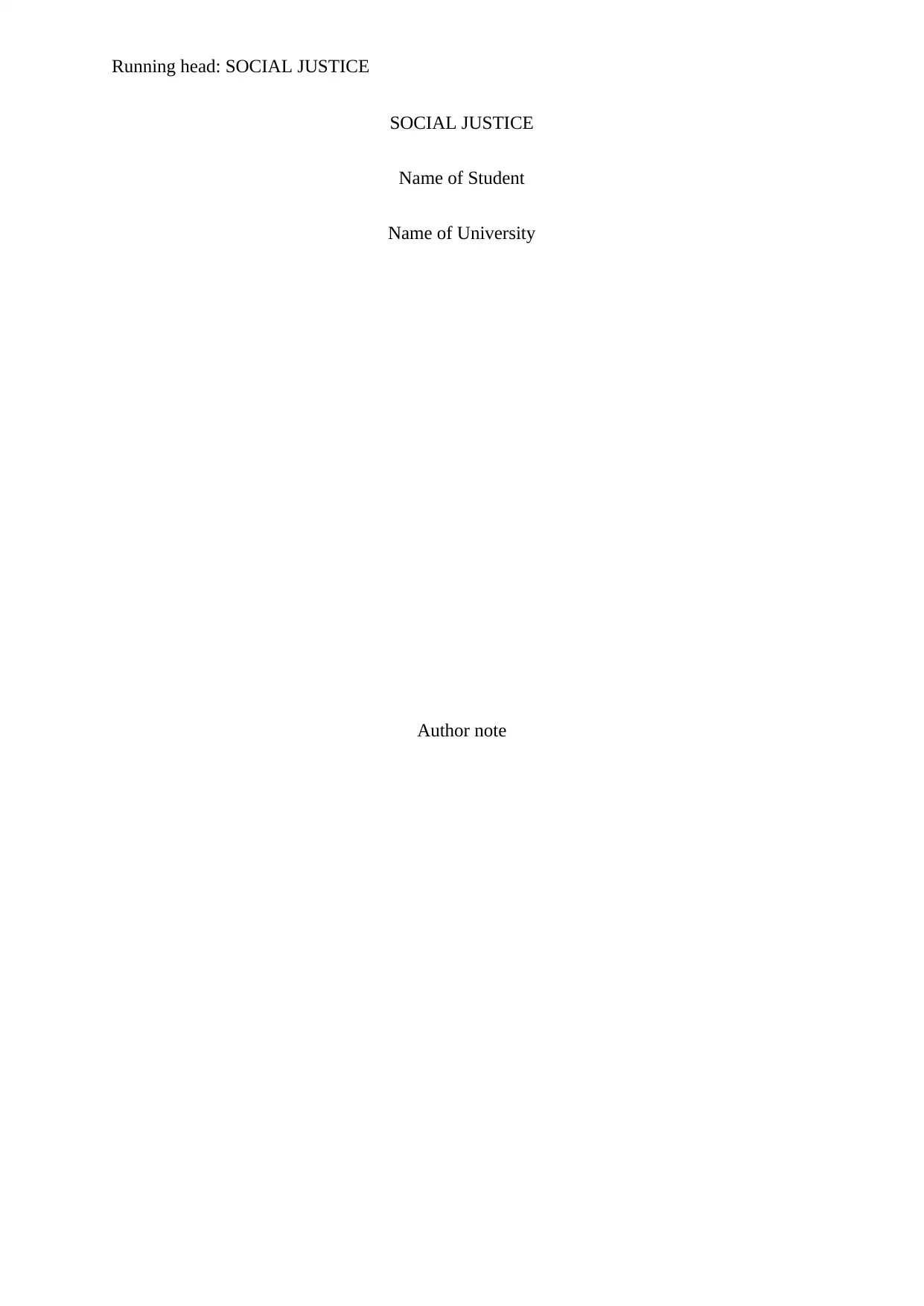
Running head: SOCIAL JUSTICE
SOCIAL JUSTICE
Name of Student
Name of University
Author note
SOCIAL JUSTICE
Name of Student
Name of University
Author note
Secure Best Marks with AI Grader
Need help grading? Try our AI Grader for instant feedback on your assignments.
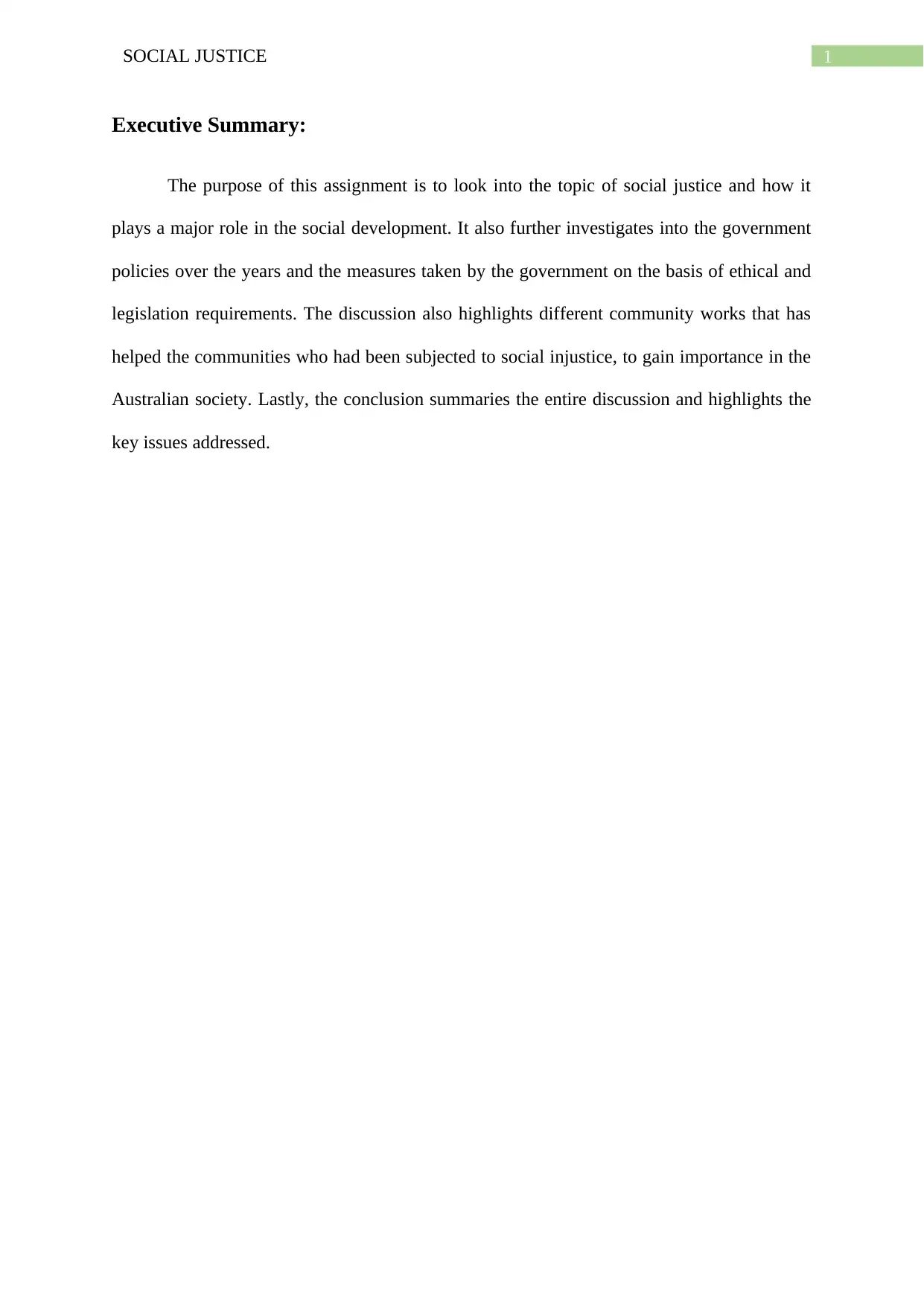
1SOCIAL JUSTICE
Executive Summary:
The purpose of this assignment is to look into the topic of social justice and how it
plays a major role in the social development. It also further investigates into the government
policies over the years and the measures taken by the government on the basis of ethical and
legislation requirements. The discussion also highlights different community works that has
helped the communities who had been subjected to social injustice, to gain importance in the
Australian society. Lastly, the conclusion summaries the entire discussion and highlights the
key issues addressed.
Executive Summary:
The purpose of this assignment is to look into the topic of social justice and how it
plays a major role in the social development. It also further investigates into the government
policies over the years and the measures taken by the government on the basis of ethical and
legislation requirements. The discussion also highlights different community works that has
helped the communities who had been subjected to social injustice, to gain importance in the
Australian society. Lastly, the conclusion summaries the entire discussion and highlights the
key issues addressed.
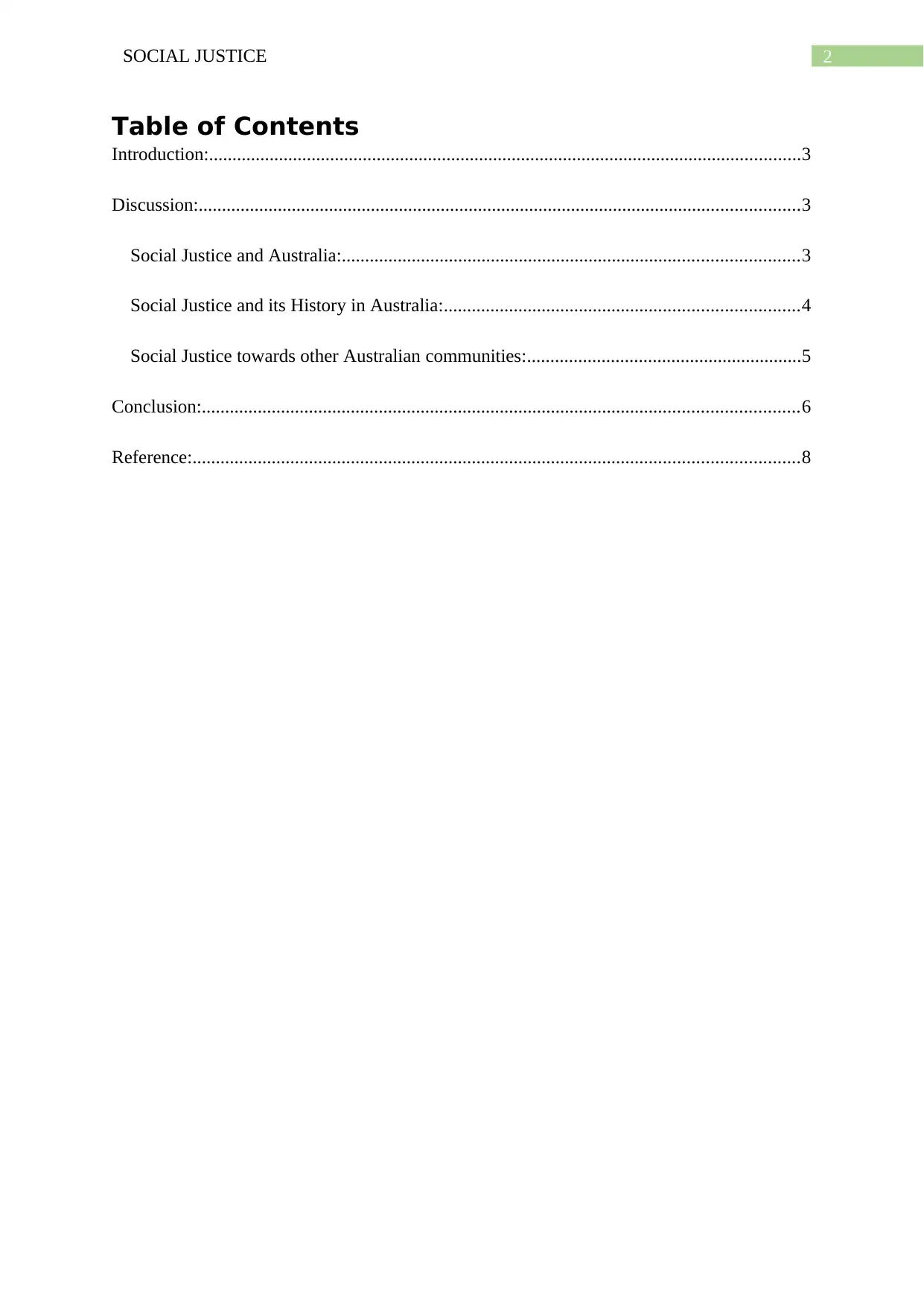
2SOCIAL JUSTICE
Table of Contents
Introduction:...............................................................................................................................3
Discussion:.................................................................................................................................3
Social Justice and Australia:..................................................................................................3
Social Justice and its History in Australia:............................................................................4
Social Justice towards other Australian communities:...........................................................5
Conclusion:................................................................................................................................6
Reference:..................................................................................................................................8
Table of Contents
Introduction:...............................................................................................................................3
Discussion:.................................................................................................................................3
Social Justice and Australia:..................................................................................................3
Social Justice and its History in Australia:............................................................................4
Social Justice towards other Australian communities:...........................................................5
Conclusion:................................................................................................................................6
Reference:..................................................................................................................................8
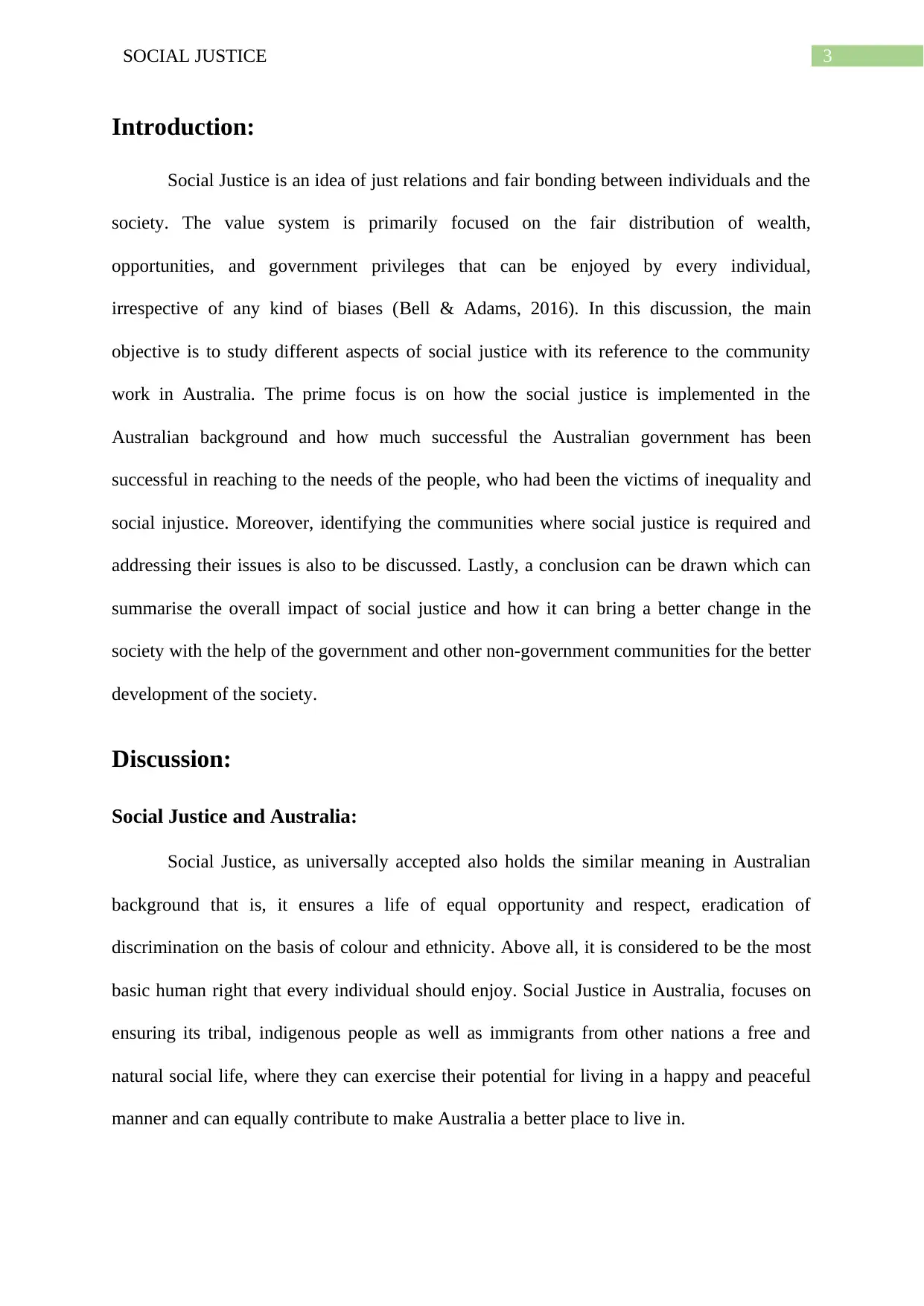
3SOCIAL JUSTICE
Introduction:
Social Justice is an idea of just relations and fair bonding between individuals and the
society. The value system is primarily focused on the fair distribution of wealth,
opportunities, and government privileges that can be enjoyed by every individual,
irrespective of any kind of biases (Bell & Adams, 2016). In this discussion, the main
objective is to study different aspects of social justice with its reference to the community
work in Australia. The prime focus is on how the social justice is implemented in the
Australian background and how much successful the Australian government has been
successful in reaching to the needs of the people, who had been the victims of inequality and
social injustice. Moreover, identifying the communities where social justice is required and
addressing their issues is also to be discussed. Lastly, a conclusion can be drawn which can
summarise the overall impact of social justice and how it can bring a better change in the
society with the help of the government and other non-government communities for the better
development of the society.
Discussion:
Social Justice and Australia:
Social Justice, as universally accepted also holds the similar meaning in Australian
background that is, it ensures a life of equal opportunity and respect, eradication of
discrimination on the basis of colour and ethnicity. Above all, it is considered to be the most
basic human right that every individual should enjoy. Social Justice in Australia, focuses on
ensuring its tribal, indigenous people as well as immigrants from other nations a free and
natural social life, where they can exercise their potential for living in a happy and peaceful
manner and can equally contribute to make Australia a better place to live in.
Introduction:
Social Justice is an idea of just relations and fair bonding between individuals and the
society. The value system is primarily focused on the fair distribution of wealth,
opportunities, and government privileges that can be enjoyed by every individual,
irrespective of any kind of biases (Bell & Adams, 2016). In this discussion, the main
objective is to study different aspects of social justice with its reference to the community
work in Australia. The prime focus is on how the social justice is implemented in the
Australian background and how much successful the Australian government has been
successful in reaching to the needs of the people, who had been the victims of inequality and
social injustice. Moreover, identifying the communities where social justice is required and
addressing their issues is also to be discussed. Lastly, a conclusion can be drawn which can
summarise the overall impact of social justice and how it can bring a better change in the
society with the help of the government and other non-government communities for the better
development of the society.
Discussion:
Social Justice and Australia:
Social Justice, as universally accepted also holds the similar meaning in Australian
background that is, it ensures a life of equal opportunity and respect, eradication of
discrimination on the basis of colour and ethnicity. Above all, it is considered to be the most
basic human right that every individual should enjoy. Social Justice in Australia, focuses on
ensuring its tribal, indigenous people as well as immigrants from other nations a free and
natural social life, where they can exercise their potential for living in a happy and peaceful
manner and can equally contribute to make Australia a better place to live in.
Secure Best Marks with AI Grader
Need help grading? Try our AI Grader for instant feedback on your assignments.
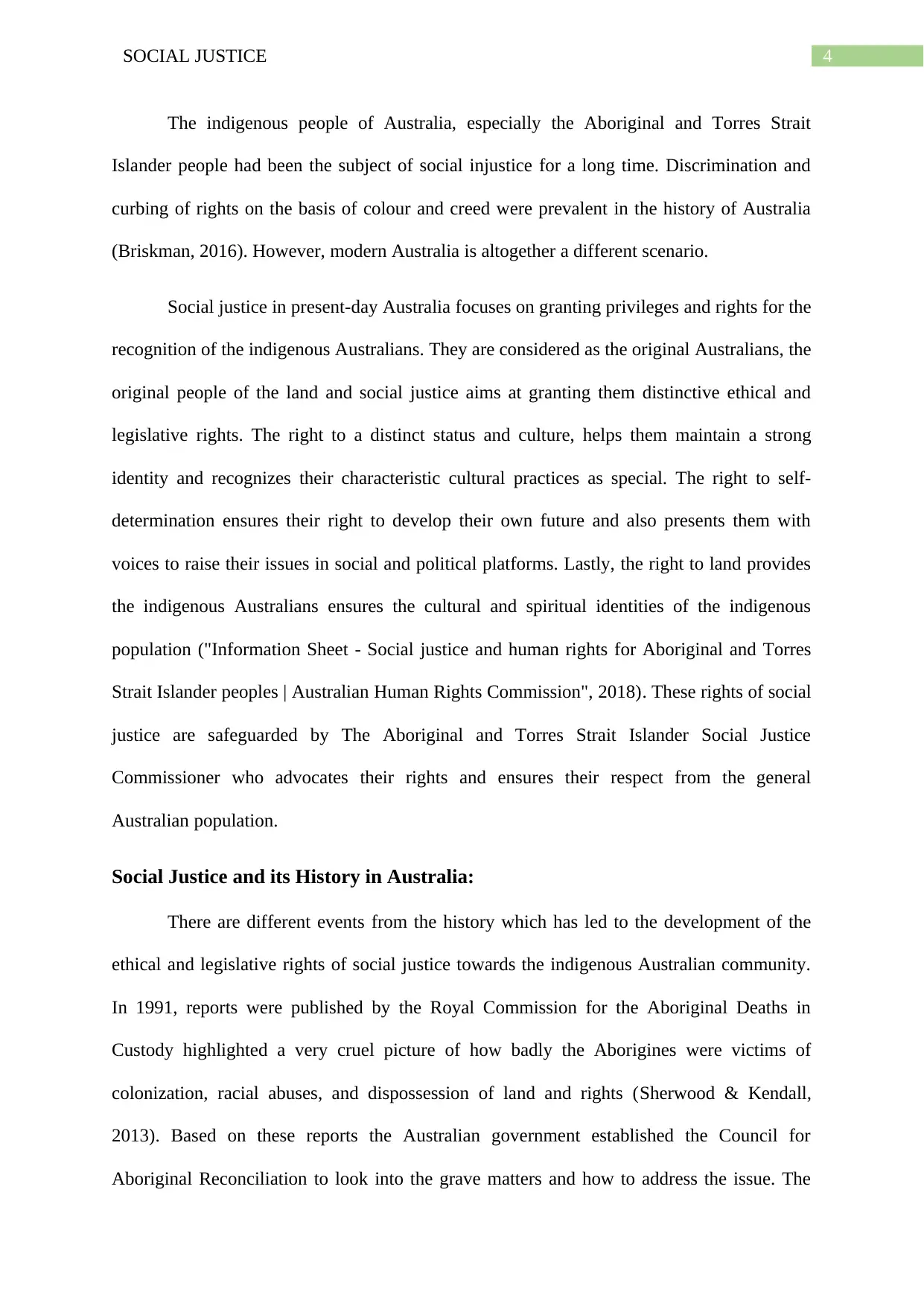
4SOCIAL JUSTICE
The indigenous people of Australia, especially the Aboriginal and Torres Strait
Islander people had been the subject of social injustice for a long time. Discrimination and
curbing of rights on the basis of colour and creed were prevalent in the history of Australia
(Briskman, 2016). However, modern Australia is altogether a different scenario.
Social justice in present-day Australia focuses on granting privileges and rights for the
recognition of the indigenous Australians. They are considered as the original Australians, the
original people of the land and social justice aims at granting them distinctive ethical and
legislative rights. The right to a distinct status and culture, helps them maintain a strong
identity and recognizes their characteristic cultural practices as special. The right to self-
determination ensures their right to develop their own future and also presents them with
voices to raise their issues in social and political platforms. Lastly, the right to land provides
the indigenous Australians ensures the cultural and spiritual identities of the indigenous
population ("Information Sheet - Social justice and human rights for Aboriginal and Torres
Strait Islander peoples | Australian Human Rights Commission", 2018). These rights of social
justice are safeguarded by The Aboriginal and Torres Strait Islander Social Justice
Commissioner who advocates their rights and ensures their respect from the general
Australian population.
Social Justice and its History in Australia:
There are different events from the history which has led to the development of the
ethical and legislative rights of social justice towards the indigenous Australian community.
In 1991, reports were published by the Royal Commission for the Aboriginal Deaths in
Custody highlighted a very cruel picture of how badly the Aborigines were victims of
colonization, racial abuses, and dispossession of land and rights (Sherwood & Kendall,
2013). Based on these reports the Australian government established the Council for
Aboriginal Reconciliation to look into the grave matters and how to address the issue. The
The indigenous people of Australia, especially the Aboriginal and Torres Strait
Islander people had been the subject of social injustice for a long time. Discrimination and
curbing of rights on the basis of colour and creed were prevalent in the history of Australia
(Briskman, 2016). However, modern Australia is altogether a different scenario.
Social justice in present-day Australia focuses on granting privileges and rights for the
recognition of the indigenous Australians. They are considered as the original Australians, the
original people of the land and social justice aims at granting them distinctive ethical and
legislative rights. The right to a distinct status and culture, helps them maintain a strong
identity and recognizes their characteristic cultural practices as special. The right to self-
determination ensures their right to develop their own future and also presents them with
voices to raise their issues in social and political platforms. Lastly, the right to land provides
the indigenous Australians ensures the cultural and spiritual identities of the indigenous
population ("Information Sheet - Social justice and human rights for Aboriginal and Torres
Strait Islander peoples | Australian Human Rights Commission", 2018). These rights of social
justice are safeguarded by The Aboriginal and Torres Strait Islander Social Justice
Commissioner who advocates their rights and ensures their respect from the general
Australian population.
Social Justice and its History in Australia:
There are different events from the history which has led to the development of the
ethical and legislative rights of social justice towards the indigenous Australian community.
In 1991, reports were published by the Royal Commission for the Aboriginal Deaths in
Custody highlighted a very cruel picture of how badly the Aborigines were victims of
colonization, racial abuses, and dispossession of land and rights (Sherwood & Kendall,
2013). Based on these reports the Australian government established the Council for
Aboriginal Reconciliation to look into the grave matters and how to address the issue. The
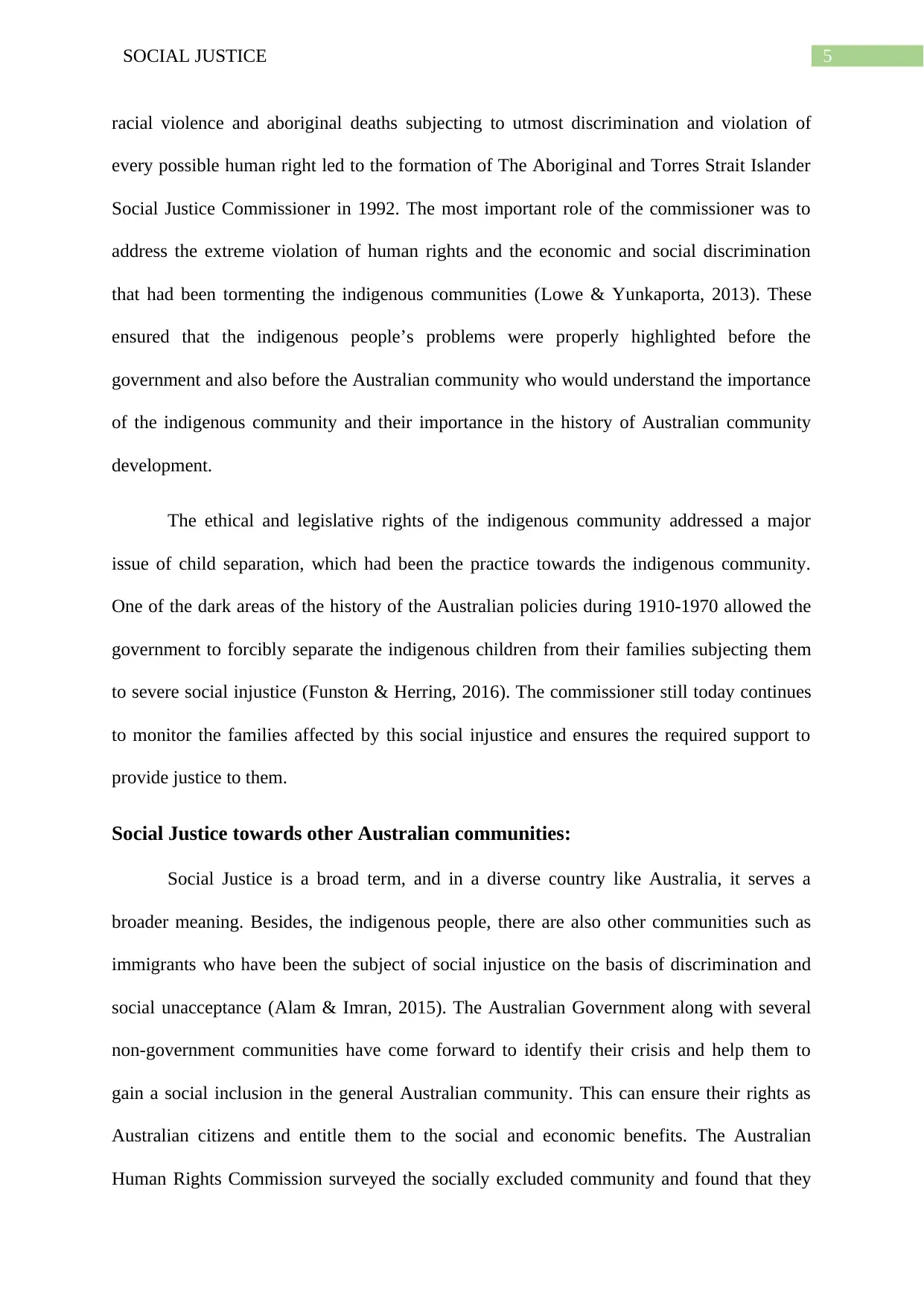
5SOCIAL JUSTICE
racial violence and aboriginal deaths subjecting to utmost discrimination and violation of
every possible human right led to the formation of The Aboriginal and Torres Strait Islander
Social Justice Commissioner in 1992. The most important role of the commissioner was to
address the extreme violation of human rights and the economic and social discrimination
that had been tormenting the indigenous communities (Lowe & Yunkaporta, 2013). These
ensured that the indigenous people’s problems were properly highlighted before the
government and also before the Australian community who would understand the importance
of the indigenous community and their importance in the history of Australian community
development.
The ethical and legislative rights of the indigenous community addressed a major
issue of child separation, which had been the practice towards the indigenous community.
One of the dark areas of the history of the Australian policies during 1910-1970 allowed the
government to forcibly separate the indigenous children from their families subjecting them
to severe social injustice (Funston & Herring, 2016). The commissioner still today continues
to monitor the families affected by this social injustice and ensures the required support to
provide justice to them.
Social Justice towards other Australian communities:
Social Justice is a broad term, and in a diverse country like Australia, it serves a
broader meaning. Besides, the indigenous people, there are also other communities such as
immigrants who have been the subject of social injustice on the basis of discrimination and
social unacceptance (Alam & Imran, 2015). The Australian Government along with several
non-government communities have come forward to identify their crisis and help them to
gain a social inclusion in the general Australian community. This can ensure their rights as
Australian citizens and entitle them to the social and economic benefits. The Australian
Human Rights Commission surveyed the socially excluded community and found that they
racial violence and aboriginal deaths subjecting to utmost discrimination and violation of
every possible human right led to the formation of The Aboriginal and Torres Strait Islander
Social Justice Commissioner in 1992. The most important role of the commissioner was to
address the extreme violation of human rights and the economic and social discrimination
that had been tormenting the indigenous communities (Lowe & Yunkaporta, 2013). These
ensured that the indigenous people’s problems were properly highlighted before the
government and also before the Australian community who would understand the importance
of the indigenous community and their importance in the history of Australian community
development.
The ethical and legislative rights of the indigenous community addressed a major
issue of child separation, which had been the practice towards the indigenous community.
One of the dark areas of the history of the Australian policies during 1910-1970 allowed the
government to forcibly separate the indigenous children from their families subjecting them
to severe social injustice (Funston & Herring, 2016). The commissioner still today continues
to monitor the families affected by this social injustice and ensures the required support to
provide justice to them.
Social Justice towards other Australian communities:
Social Justice is a broad term, and in a diverse country like Australia, it serves a
broader meaning. Besides, the indigenous people, there are also other communities such as
immigrants who have been the subject of social injustice on the basis of discrimination and
social unacceptance (Alam & Imran, 2015). The Australian Government along with several
non-government communities have come forward to identify their crisis and help them to
gain a social inclusion in the general Australian community. This can ensure their rights as
Australian citizens and entitle them to the social and economic benefits. The Australian
Human Rights Commission surveyed the socially excluded community and found that they
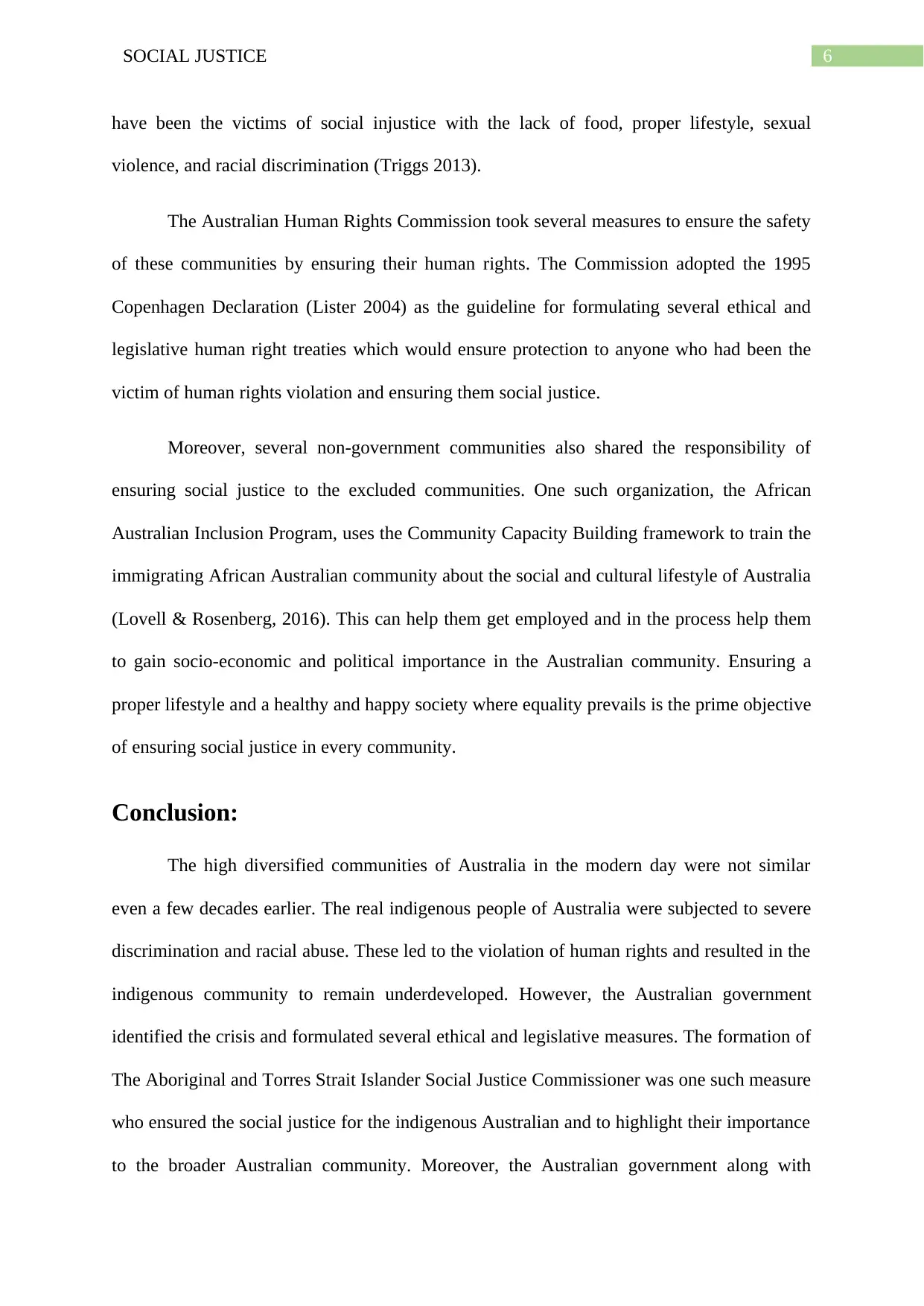
6SOCIAL JUSTICE
have been the victims of social injustice with the lack of food, proper lifestyle, sexual
violence, and racial discrimination (Triggs 2013).
The Australian Human Rights Commission took several measures to ensure the safety
of these communities by ensuring their human rights. The Commission adopted the 1995
Copenhagen Declaration (Lister 2004) as the guideline for formulating several ethical and
legislative human right treaties which would ensure protection to anyone who had been the
victim of human rights violation and ensuring them social justice.
Moreover, several non-government communities also shared the responsibility of
ensuring social justice to the excluded communities. One such organization, the African
Australian Inclusion Program, uses the Community Capacity Building framework to train the
immigrating African Australian community about the social and cultural lifestyle of Australia
(Lovell & Rosenberg, 2016). This can help them get employed and in the process help them
to gain socio-economic and political importance in the Australian community. Ensuring a
proper lifestyle and a healthy and happy society where equality prevails is the prime objective
of ensuring social justice in every community.
Conclusion:
The high diversified communities of Australia in the modern day were not similar
even a few decades earlier. The real indigenous people of Australia were subjected to severe
discrimination and racial abuse. These led to the violation of human rights and resulted in the
indigenous community to remain underdeveloped. However, the Australian government
identified the crisis and formulated several ethical and legislative measures. The formation of
The Aboriginal and Torres Strait Islander Social Justice Commissioner was one such measure
who ensured the social justice for the indigenous Australian and to highlight their importance
to the broader Australian community. Moreover, the Australian government along with
have been the victims of social injustice with the lack of food, proper lifestyle, sexual
violence, and racial discrimination (Triggs 2013).
The Australian Human Rights Commission took several measures to ensure the safety
of these communities by ensuring their human rights. The Commission adopted the 1995
Copenhagen Declaration (Lister 2004) as the guideline for formulating several ethical and
legislative human right treaties which would ensure protection to anyone who had been the
victim of human rights violation and ensuring them social justice.
Moreover, several non-government communities also shared the responsibility of
ensuring social justice to the excluded communities. One such organization, the African
Australian Inclusion Program, uses the Community Capacity Building framework to train the
immigrating African Australian community about the social and cultural lifestyle of Australia
(Lovell & Rosenberg, 2016). This can help them get employed and in the process help them
to gain socio-economic and political importance in the Australian community. Ensuring a
proper lifestyle and a healthy and happy society where equality prevails is the prime objective
of ensuring social justice in every community.
Conclusion:
The high diversified communities of Australia in the modern day were not similar
even a few decades earlier. The real indigenous people of Australia were subjected to severe
discrimination and racial abuse. These led to the violation of human rights and resulted in the
indigenous community to remain underdeveloped. However, the Australian government
identified the crisis and formulated several ethical and legislative measures. The formation of
The Aboriginal and Torres Strait Islander Social Justice Commissioner was one such measure
who ensured the social justice for the indigenous Australian and to highlight their importance
to the broader Australian community. Moreover, the Australian government along with
Paraphrase This Document
Need a fresh take? Get an instant paraphrase of this document with our AI Paraphraser
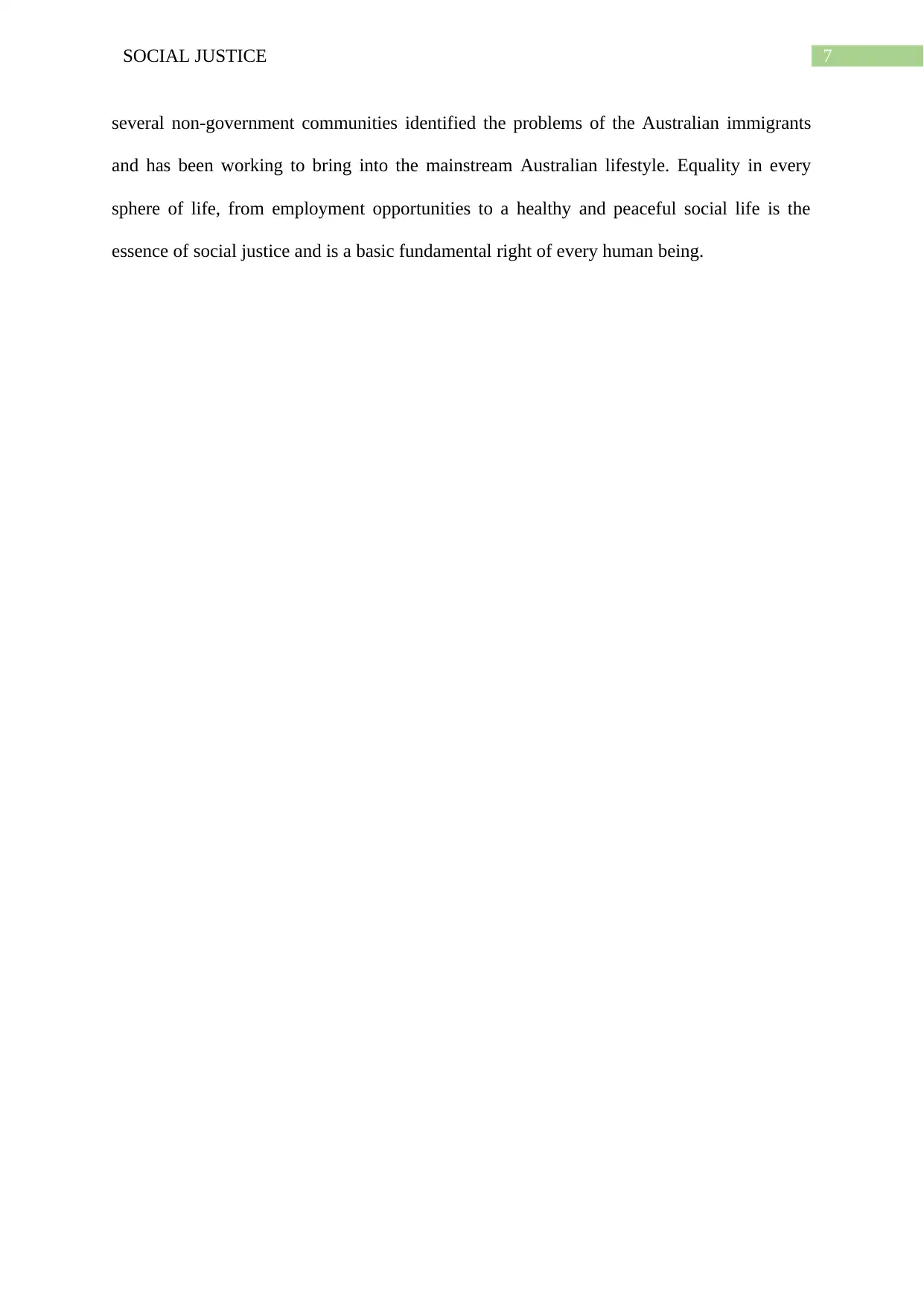
7SOCIAL JUSTICE
several non-government communities identified the problems of the Australian immigrants
and has been working to bring into the mainstream Australian lifestyle. Equality in every
sphere of life, from employment opportunities to a healthy and peaceful social life is the
essence of social justice and is a basic fundamental right of every human being.
several non-government communities identified the problems of the Australian immigrants
and has been working to bring into the mainstream Australian lifestyle. Equality in every
sphere of life, from employment opportunities to a healthy and peaceful social life is the
essence of social justice and is a basic fundamental right of every human being.

8SOCIAL JUSTICE
Reference:
Alam, K., & Imran, S. (2015). The digital divide and social inclusion among refugee
migrants: A case in regional Australia. Information Technology & People, 28(2), 344-
365.
Bell, L. A., & Adams, M. (2016). Theoretical foundations for social justice education. In
Teaching for diversity and social justice (pp. 21-44). Routledge.
Briskman, L. (2016). Decolonizing social work in Australia: Prospect or illusion. In
Indigenous Social Work around the World (pp. 111-122). Routledge.
Funston, L., & Herring, S. (2016). When Will the Stolen Generations End? A Qualitative
Critical Exploration of Contemporary'Child Protection'Practices in Aboriginal and
Torres Strait Islander Communities. Sexual Abuse in Australia and New Zealand,
7(1), 51.
Information Sheet - Social justice and human rights for Aboriginal and Torres Strait Islander
peoples | Australian Human Rights Commission. (2018). Retrieved from
https://www.humanrights.gov.au/our-work/aboriginal-and-torres-strait-islander-
social-justice/guides/information-sheet-social#main-search
Lister, R. (2004). A politics of recognition and respect: Involving people with experience of
poverty in decision-making that affects their lives. In The politics of inclusion and
empowerment (pp. 116-138). Palgrave Macmillan, London.
Lovell, S. A., & Rosenberg, M. W. (2016). 6 Community capacity building through
qualitative methodologies. Practicing Qualitative Methods in Health Geographies,
92.
Reference:
Alam, K., & Imran, S. (2015). The digital divide and social inclusion among refugee
migrants: A case in regional Australia. Information Technology & People, 28(2), 344-
365.
Bell, L. A., & Adams, M. (2016). Theoretical foundations for social justice education. In
Teaching for diversity and social justice (pp. 21-44). Routledge.
Briskman, L. (2016). Decolonizing social work in Australia: Prospect or illusion. In
Indigenous Social Work around the World (pp. 111-122). Routledge.
Funston, L., & Herring, S. (2016). When Will the Stolen Generations End? A Qualitative
Critical Exploration of Contemporary'Child Protection'Practices in Aboriginal and
Torres Strait Islander Communities. Sexual Abuse in Australia and New Zealand,
7(1), 51.
Information Sheet - Social justice and human rights for Aboriginal and Torres Strait Islander
peoples | Australian Human Rights Commission. (2018). Retrieved from
https://www.humanrights.gov.au/our-work/aboriginal-and-torres-strait-islander-
social-justice/guides/information-sheet-social#main-search
Lister, R. (2004). A politics of recognition and respect: Involving people with experience of
poverty in decision-making that affects their lives. In The politics of inclusion and
empowerment (pp. 116-138). Palgrave Macmillan, London.
Lovell, S. A., & Rosenberg, M. W. (2016). 6 Community capacity building through
qualitative methodologies. Practicing Qualitative Methods in Health Geographies,
92.

9SOCIAL JUSTICE
Lowe, K., & Yunkaporta, T. (2013). The inclusion of Aboriginal and Torres Strait Islander
content in the Australian National Curriculum: A cultural, cognitive and socio-
political evaluation. Curriculum Perspectives, 33(1), 1-14.
Sherwood, J., & Kendall, S. (2013). Reframing spaces by building relationships: Community
collaborative participatory action research with Aboriginal mothers in prison.
Contemporary nurse, 46(1), 83-94.
Triggs, G. (2013). Social Inclusion and Human Rights in Australia | Australian Human Rights
Commission. Retrieved from https://www.humanrights.gov.au/news/speeches/social-
inclusion-and-human-rights-australia
Lowe, K., & Yunkaporta, T. (2013). The inclusion of Aboriginal and Torres Strait Islander
content in the Australian National Curriculum: A cultural, cognitive and socio-
political evaluation. Curriculum Perspectives, 33(1), 1-14.
Sherwood, J., & Kendall, S. (2013). Reframing spaces by building relationships: Community
collaborative participatory action research with Aboriginal mothers in prison.
Contemporary nurse, 46(1), 83-94.
Triggs, G. (2013). Social Inclusion and Human Rights in Australia | Australian Human Rights
Commission. Retrieved from https://www.humanrights.gov.au/news/speeches/social-
inclusion-and-human-rights-australia
1 out of 10
Related Documents
Your All-in-One AI-Powered Toolkit for Academic Success.
+13062052269
info@desklib.com
Available 24*7 on WhatsApp / Email
![[object Object]](/_next/static/media/star-bottom.7253800d.svg)
Unlock your academic potential
© 2024 | Zucol Services PVT LTD | All rights reserved.





